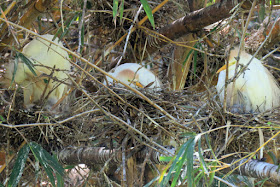 |
| Great Egret |
One day, we drove to a nearby university which had a large lake on the campus. A lake was filled with both familiar and unfamiliar water birds. Nesting was the activity of the day!
 |
| Cattle Egret |
Breeding plumage was displayed for all to admire, and admire it we did!
 |
| Cattle Egret Rookery |
What in the world are all those white spots in that big bamboo overhanging the lake?
 |
| Cattle Egret Nests |
Oh yes! The Cattle Egrets don't care about personal space when they are nesting. I guess there is safety in numbers.
 |
| Anhinga and chicks |
The Anhinga chicks are large enough to be very demanding. Feed us NOW! They look about ready to fall right out of the nest.
 |
| Jacana and chicks |
The Northern Jacana chicks are precocial and ready to walk around looking for food soon after hatching.
I love their long toes that allow them to walk on the lily pads.
When they come in for a landing, they have yellow wings and an extra "finger" extending from their wrists. This was way across the lake, sorry it's not closer.
 |
| Purple Gallinule |
|
The Purple Gallinule which we just saw in Florida, pulls up the edge of a lily pad and holds it down with his long toes while searching the underside for edibles.
 |
| Boat-billed Heron |
I thought this was a Black-crowned Night Heron at first. Then Glenn told us to look at the beak. Not sure what advantage this large thick beak gives him.
 |
| Torrent Tyranulets |
The American Dippers swim in the raging mountain streams, just like they do in Colorado. But these little Torrent Tyranulets are flycatchers, living in the highlands of Costa Rica. Instead of perching on a twig, they do their flycatching from a big rock in the stream.
 |
| Sun Bittern |
We walked down a long and muddy road looking for a Sun Bittern along the rocks. We tracked it along the rocks for a while, but did not see it displaying.
According to Cornell's website, the spectacular frontal display
of the Sun bittern has been documented only in threat and defensive
situations, with little evidence supporting any role in courtship
behavior The defensive role of this display also is supported by the fact that
the colorful wing patterns are obtained by both sexes with no
intermediate plumage types, as well as by the fact that young
Sun bitterns begin practicing the display at an early age.
 |
| Amazon Kingfisher |
The Amazon Kingfisher has an extra long and heavy bill, but seems to behave just like the ones we know here at home.














No comments:
Post a Comment